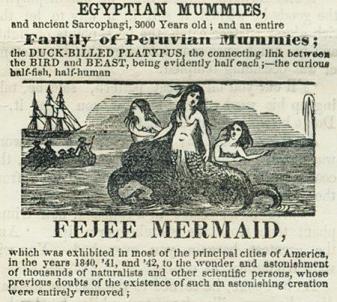A small shriveled, grotesque creature with a fishtail took New York by storm in the 1840s. Thousands of people flocked to see this creature, called the Feejee mermaid, spending their hard-earned money for a glimpse of this shriveled specimen. Why did so many people come to see what should have seemed like such an obvious hoax? P. T. Barnum, the owner of the Feejee mermaid, exploited the news for his own good.
The idea of a mermaid has been one that transverses across centuries and cultures. From the mention of sirens in Greek mythology to Denmark’s The Little Mermaid by Hans Christian Anderson, mermaids are a well-established part of lore. This history of acknowledgment of mermaid-like creatures sets the scene for the Feejee mermaid. The origins of the Feejee mermaid are traced back to early nineteenth-century Japan, where a fisherman constructed it. He claimed that only owning a picture of the mermaid would thwart an imminent wave of sterility. A Japanese sailor then bought the mermaid and later sold it to an American sea captain, who willed it to his son, who sold it to the Boston Museum, who then connected it with its most notable owner, P. T. Barnum.
As the new owner of the Feejee Mermaid, Barnum saw its star potential. But just like the main female character in any given 1990s romcom, he needed to give it a makeover. Barnum knew that the public would not pay to see just another smalltime hoax.
Barnum used many tactics to hype up the mermaid. Barnum knew that people would be more likely to believe that the mermaid was real if a doctor said that it was. So he created one, named Dr. Griffin. The elusive Dr. Griffin was actually just one of Barnum’s cronies playing the part. Dr.Griffin was said to have returned from Africa with the specimen Feejee mermaid in his custody. This fake doctor legitimized the Feejee mermaid, making the information about the mermaid seem more likely to be real.
Barnum also created demand for the Feejee mermaid through the manipulation of the news. Barnum masterminded a public argument, between himself and Dr. Griffin. The argument was over the displaying of the Feejee mermaid at Barnum’s museum. Barnum publicly urged Dr. Griffin to let the world bask in the wonder of the mermaid whereas Dr. Griffin, following his script, declined. Finally, when Dr. Griffin relented, the public was sitting on the edge of their seats, ready to claim what they had been denied. Barnum expertly created demand for the mermaid using the media to magnify it.
Another manipulation of the news, in the case of the Feejee mermaid, was through the misrepresentation of its appearance. While the actual mermaid was a mess of remnants, Barnum advertised it as a well-endowed, human-sized woman with a fishtail, the mermaid of everyone’s childhood fairytales. The introduction of a beautiful, sexualized woman was a calculated decision on Barnum’s part. Manufacturing these sexy images stimulated interest in the mermaid even more.
P.T. Barnum himself admitted to his use of fake news. Barnum published a book called Humbugs of the World, in which he, surprisingly, labeled himself as a person who spread “humbug,” but not a liar. He argued that using any means possible to attract the public eye does not hurt one’s integrity. He justified his manipulation of audiences by arguing that those duped into showing up to see the fantastical mermaid (or whatever idea he had been peddling) still got their money’s worth even if it was not what they expected. He wrote, “there are various trades and occupations which need only notoriety to insure success, always provided that when customers are once attracted, they never fail to get their money’s worth.” Barnum believed that as long as he delivered on his promise of entertainment, he is not a liar just a perpetrator of humbug.
P.T. Barnum is now dubbed one of the greatest advertisers in history. This greatness shows in how his tactics are still used today in advertising. Like how Barnum used Dr. Griffin as a reputable source to vouch for the mermaid, people with some kind of sway are still often used to sell products. Think about the commonly used “nine out of ten doctors would recommend”, or the token celebrity in a facewash advertisement. Demand creation is another one of Barnum’s Feejee mermaid advertising methods still commonly used. Limited production of certain products is commonly used to make the public interested in a product. Barnum’s tactic of sexualization is also widely used in advertising today. Brands will plaster a bikini-clad woman onto nearly any product.
Barnum’s ability to manipulate the press and public opinion is astounding. Through the lens of the Feejee mermaid, one can explore some of the earliest uses of advertising tactics, and become more informed about how advertisers manipulate public opinion today.
